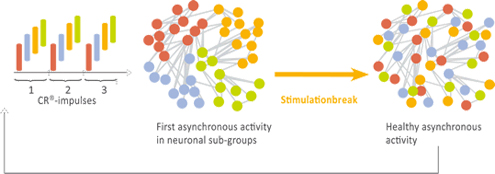CR® Neuromodulation
CR® Neuromodulation Treatment is currently not available in any country, due to issues arising with the manufacturing company. The Tinnitus & Hearing Clinic is pleased to be able to offer other evidence-based tinnitus treatments, suitable for a wider range of patient profiles. The treatment was successful for a specific, small group of patients and we hope the treatment will be available in the future. The information below relates to the principal of CR® Neuromodulation. Firstly, targeted impulses are used to disrupt the highly synchronous neuronal network, whereby the impulses have to be offset both spatially and chronologically. The impulses address different spatial areas and split the synchronous nerve cell assembly into four spatially separated sub-groups. Each sub-group is synchronous within itself – however, their cycles are different due to the chronological offset of the impulses transmitted to the different areas.

Splitting of the synchronous, heavily networked cell assembly into sub-groups
The spatially and chronologically offset impulses are transmitted in multiple short bursts (sequences 1 to 3) to split the synchronous, heavily networked cell assembly fully into its sub-groups
Complete asynchronisation through the principle of self-organisation
The impulses are followed by a pause – and Nature is given free rein: based on the so-called “principle of self–organisation”, the neurons of one sub-group striving pathologically to achieve synchronisation attempt to synchronise with the cells of another sub-group (one that is “ticking” in a different cycle) – and end up in a completely asynchronous state in the short term. “Healthy” asynchronous chaos rules! You can try using the image of singing a canon to imagine what happens: first of all, each group sings their allocated verse. Then they are instructed to sing the same verse – but without a conductor! All of the singers will sing happily along, albeit in a state of disarrangement – until, after a while, they harmonise their singing.

Complete asynchronisation
What Does Tinnitus Sound Like?
The Causes of Tinnitus
Our video explains the neurological causes of tonal tinnitus.
Request An Information Pack
Our Clinics
"I would say that if you have the chance then try the treatment because it has worked for me and I would never have believed it when I was given the devices."
Janice Dyson
treated at our Manchester clinic

